|
|

NANOGENERATOR: Professor Wang Zhonglin displays flexible charge pumps that are able to produce alternating current through the stretching and relaxing of zinc oxide wires (GARY MEEK) |
When you're indulging in a beautiful melody and your MP3 player suddenly runs out of power, what do you do? If you wear nanofiber clothing, you can get power back easily just by taking a stroll or waving your sleeves.
This futuristic clothing contains nanogenerators that convert mechanical energy from body movement, the heart beating, wind blowing or sound vibrations into electricity.
"Walking can produce 67 watts of energy, and wagging your fingers can generate 0.1 watts," said Wang Zhonglin, Professor at the School of Material Science and Engineering and Director of the Center for Nanostructure Characterization at the Georgia Institute of Technology in the United States.
According to Wang, if we convert 17 to 30 percent of the energy into electricity, it is enough to power small devices. Every square meter of electricity-generating fiber can produce up to 80 mw, enough to power an MP3 player or cell phone. Nanofiber clothing can also be used by hikers and soldiers and to power devices used in medical sensing, environmental monitoring, defense technology and personal electronics.
Currently, the electricity-generating clothing is not available in stores. A sticking point in its development is how to make it washable. Because it contains zinc oxide that is soluble in water, it has to be protected from moisture.
"Our new flexible charge pump resolves several key issues with our previous generators," Wang said. "The new design would be more robust, eliminating the problem of moisture infiltration and the wearing of the structures. From a practical standpoint, this would be a major advantage."
How it works
Nanotechnology is used to produce electricity-generating clothing. Nano is a length unit. One nanometer equals 1 billionth of a meter, which is equivalent to the diameter of four atoms. "Enlarging an atom 1 billion times, we get the size of a table tennis ball; while enlarging a table tennis ball 1 billion times, we get the size of a moon," said Wang.
Nanomaterial is material with particles smaller than 100 nanometers in at least one dimension. When particles that build the material are reduced to the size of a nanometer, or more or less the scale of an atom, the material can exhibit different properties. Theoretically speaking, if nanotechnology makes atoms the building block for materials, innumerable novel materials can be produced.
"Nanomaterial is a new direction in material science. Right now, nanotechnology research is still in its infancy, so a lot more is to be done," Wang said.
Wang and his research team make textile fibers generate electrical current using the piezoelectric effect. The piezoelectric effect was discovered in 1880 by French physicist Jacques Curie and his brother, Pierre Curie. They discovered that when some materials, such as crystal, were pressed to deform, an electric voltage was produced. Such materials are called piezoelectric materials.
| 